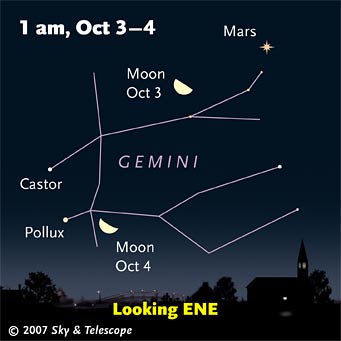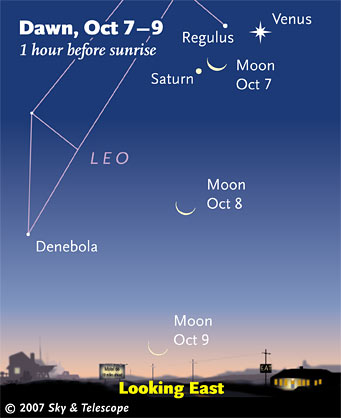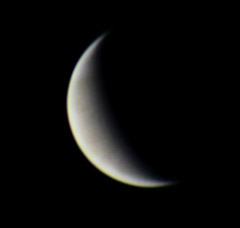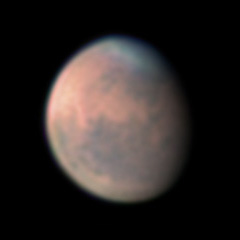Some daily events in the changing sky for September 28 – October 6.

Mars shines in the feet of Gemini late in the night this week. (These scenes are drawn for the middle of North America. European observers: move each Moon symbol a quarter of the way toward the one for the previous date. For clarity, the Moon is shown three times actual size.)
Sky & Telescope diagram
Friday, September 28
Saturday, September 29
Sunday, September 30
Monday, October 1
Tuesday, October 2
Wednesday, October 3
Thursday, October 4
Friday, October 5
Saturday, October 6

Venus, Saturn, and Regulus perform a three-way tango in the early dawn this week and next. And on Sunday morning October 7th, the waning crescent Moon shines smack in their midst! This is worth setting your alarm clock and going out with your telescope. Start observing 90 minutes before sunrise. (To find your sunrise time, make sure you've put your location into our online almanac. If you're on daylight saving time, make sure the Daylight Saving Time box is checked.)
Sky & Telescope diagram
Want to become a better amateur astronomer? Learn your way around the constellations. They're the key to locating everything fainter and deeper to hunt with binoculars or a telescope. For an easy-to-use constellation guide covering the whole evening sky, use the big monthly foldout map in each issue of Sky & Telescope, the essential magazine of astronomy. Or download our free Getting Started in Astronomy booklet (which only has bimonthly maps).
Once you get a telescope, to put it to good use you'll need a detailed, large-scale sky atlas (set of maps; the standard is Sky Atlas 2000.0) and good deep-sky guidebooks (such as Sky Atlas 2000.0 Companion by Strong and Sinnott, the even more detailed Night Sky Observer's Guide by Kepple and Sanner, or the enchanting though somewhat dated Burnham's Celestial Handbook). Read how to use them effectively.
More beginners' tips: "How to Start Right in Astronomy".
This Week's Planet Roundup

Venus is becoming a thicker crescent in a telescope as it climbs higher up away from the Sun in the morning sky. Sean Walker made this image from red, green, blue, and ultraviolet video stacks on the morning of September 25, 2007. Click image for separate RGB and ultraviolet views.
S&T: Sean Walker
Mercury (magnitude 0) is deep in the glow of sunset, in the midst of a poor apparition for the Northern Hemisphere. And it's starting to fade. Try looking for it with binoculars about 20 minutes after sundown just above the west-southwest horizon.
Venus (magnitude –4.7, in Leo) blazes high in the east before and during dawn. Watch Venus closing in day by day on Regulus and Saturn, which are to its lower left.
A telescope shows that Venus is a crescent, thickening from week to week even as it shrinks into the distance.
Mars (magnitude –0.1, moving from Taurus into Gemini) rises around 10:30 p.m. daylight saving time and shines very high in the south at dawn. Compare its fiery color with those of fainter Aldebaran (high to its upper right late at night) and Betelgeuse (less far to Mars's right or lower right).

Mars was just shy of 10 arcseconds when this picure was taken at 7:20 Universal Time on September 30th. Mare Erythraeum dominates this hemisphere across the south, with the three "fingers" of Aurorae Sinus stretch left of the center.
Sean Walker
In a telescope, Mars appears gibbous and 9.5 to 10 arcseconds in diameter. It will reach 16" diameter around its Christmas-season opposition. The Martian dust storms of July and August have abated, and while the planet's atmosphere is still bright and hazy with dust, surface features are showing through somewhat better. But they're still low-contrast.
Jupiter (magnitude –2.0, in southern Ophiuchus) glares in the southwest during and just after twilight. It sets by midevening. Antares, less bright, sparkles redly 7° below it.
Saturn (magnitude +0.7) is the brightest "star" not far lower left of bright Venus in the dawn. Fainter Regulus (magnitude +1.4) is more or less between them.
Uranus (magnitude 5.8, in Aquarius) and Neptune (magnitude 7.9, in Capricornus) are well placed in the southeast to south during evening. Finder charts for them are in the July Sky & Telescope, page 60, and online. With a big scope you can shoot for their faint moons! See the October Sky & Telescope, page 69.
Pluto (magnitude 14.0, in Sagittarius) is sinking in the southwest after dark.
All descriptions that relate to your horizon — including the words up, down, right, and left — are written for the world's midnorthern latitudes. Descriptions that also depend on longitude (mainly Moon positions) are for North America. Eastern Daylight Time (EDT) equals Universal Time (UT, UTC, or GMT) minus 4 hours.
To be sure you always get the current Sky at a Glance, bookmark this URL:
http://SkyandTelescope.com/observing/ataglance?1=1
 0
0
Comments
You must be logged in to post a comment.